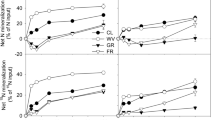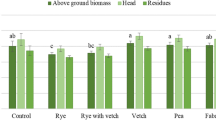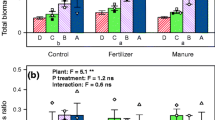Abstract
A 12-week greenhouse experiment was conducted to determine the effect of the polyphenol, lignin and N contents of six legumes on their N mineralization rate in soil and to compare estimates of legume-N release by the difference and 15N-recovery methods. Mature tops of alfalfa (Medicago sativa L.), round leaf cassia (Cassia rotundifolia Pers., var. Wynn), leucaena (Leucaena leucocephala Lam., deWit), Fitzroy stylo (Stylosanthes scabra Vog., var Fitzroy), snail medic (Medicago scutellata L.), and vigna (Vigna trilobata L., var verde) were incorporated in soil at the rate of 100 mg legume N kg-1 soil. The medic and vigna were labeled with 15N. Sorghum-sudan hybrid (Sorghum bicolor, L. Moench) was used as the test crop. A non-amended treatment was used as a control. Net N mineralization after 12 weeks ranged from 11% of added N with cassia to 47% of added N for alfalfa. With the two legumes that contained less than 20 g kg-1 of N, stylo and cassia, there was net N immobilization for the first 6 weeks of the experiment. The legume (lignin + polyphenol):N ratio was significantly correlated with N mineralization at all sampling dates at the 0.05 level and at the 0.01 level at 6 weeks (r2=0.866). Legume N, lignin, or polyphenol concentrations or the lignin:N ratio were not significantly correlated with N mineralization at any time. The polyphenol:N ratio was only significantly correlated with N mineralization after 9 weeks (r2=0.692). The (lignin + polyphenol):N ratio appears to be a good predictor of N mineralization rates of incorporated legumes, but the method for analyzing plant polyphenol needs to be standardized. Estimates of legume-N mineralization by the difference and 15N recovery methods were significantly different at all sampling dates for both 15N-labeled legumes. After 12 weeks, estimates of legume-N mineralization averaged 20% more with the difference method than with the 15N recovery method. This finding suggests that estimates of legume N available to subsequent crops should not be based solely on results from 15N recovery experiments.
Similar content being viewed by others
References
Anonymous, 1989 Abstracts. International Conference on Sustainable Agricultural Systems. Columbus, OH.
Azam F, Malik K A and Sajjad M I 1985 Transformations in soil and availability to plants of 15N applied as inorganic fertilizer and legume residues. Plant and Soil 86, 3–13.
Barnes R F, Ball P R, Brougham R W, Marten G C and Minson D J 1985 Eds. Forage Legumes for Energy Efficient Animal Production. USDA/ARS, Washington, DC, 000 p.
Black C A 1968 Soil Conditions and Plant Growth. 2nd ed. J. Wiley, NY, 000 p.
Bohn P J and S L Fales 1990 A comparison of two pretreatments on phenolic acid yield in three species. J. Sci. Food Agric. (In Press).
Burns R E 1963 Methods of tannin analysis for forage crop evaluation. Georgia Agric. Expt. Station Tech. Bull. N. S. 32. Athens, GA.
Cochran V L, Elliot L F and Papendick R I 1977 The production of phytotoxins from surface crop residues. Soil Sci. Soc. Amer. J. 41, 903–908.
Frankenberger W TJr. and Abdelmagid H M 1985 Kinetic parameters of nitrogen mineralization rates of leguminous crops incorporated into soil. Plant and Soil 87, 257–271.
Genstat 5 Committee 1987 Genstat Reference Manual. Clarendon Press, Oxford.
Haynes R J 1986 The decomposition process: Mineralization, immobilization, humus formation and degradation. In Mineral Nitrogen in the Plant-Soil System. Ed. R J Haynes. pp 52–176. Academic Press, Oralando, FL.
Iritani W M and Arnold C Y 1960 Nitrogen release of vegetable crop residues during incubation as related to their chemical composition. Soil Sci. 89, 74–82.
Jansson S L 1958. Tracer studies on nitrogen transformations in soil with special attention to mineralization-immobilization relationships. Annals Royal Agric. Col. Sweden 24, 101–361.
Jansson S L and Persson J 1982 Mineralization and immobilization of soil nitrogen. In Nitrogen in Agricultural Soils. Ed. F J Stevenson. pp 129–166. Amer. Soc. Agron. Monograph No. 9, Madison, WI.
Janzen H H and Kucey R M N 1988 C, N, and S mineralization of crop residues as influenced by crop species and nutrient regime. Plant and Soil 106, 35–41.
Jenkinson D S, Fox R H and Rayner J H 1985 Interactions between fertilizer nitrogen and soil nitrogen-the so-called ‘priming’ effect. J. Soil Sci. 36, 425–444.
Keeney D R and Nelson D W 1982 Nitrogen-inorganic forms. In Methods of Soil Analysis. Part 2, Chemical and Microbiological Properties. Agron. Monograph No. 9 (2nd ed.). Eds. A L Page et al. pp 643–698 Amer. Soc. Agron., Madison, WI.
Kimber R W L 1973 Phytotoxicity from plant residues. II. The effect of time of rotting of straw from some grasses and legumes on the growth of wheat seedlings. Plant and Soil 38, 347–361.
King H G C and Heath G W 1967 The chemical analysis of small samples of leaf material and the relationship between the disappearance and composition of leaves. Pedobiologia 7, 192–197.
Ladd J N and Amato M 1986 The fate of nitrogen from legume and fertilizer sources in soils successively cropped with wheat under field conditions. Soil Biol. Biochem. 18, 417–425.
Martin A E and Ross P J 1968 A nitrogen-balance study using labelled fertilizer in a gas lysimeter. Plant and Soil 28, 182–186.
McLeod M N 1974 Plant tannins — their role in forage quality. Nutrition Abst. Reviews 44, 804–815.
Melillo J M, Aber J D and Muratore J F 1982 Nitrogen and lignin control of hardwood leaf litter decomposition dynamics. Ecology 63, 621–626.
Muller M M, Sundman V, Soininvaara O and Merilainen A 1988 Effect of chemical composition on the release of nitrogen from agricultural plant materials decomposing in soil under field conditions. Biol. Fert. Soils 6, 78–83.
Palm C A and Sanchez P A 1990 Nitrogen release from some tropical legumes as affected by lignin and polyphenol contents. Soil Biol. Biochem. (In Press).
Stevenson F J 1986 Cycles of Soil. Carbon, Nitrogen, Phosphorus, Sulfur, Micronutrients. J. Wiley, New York.
Vallis I 1983 Uptake by grass and transfer to soil of nitrogen from 15N-labeled legume materials applied to a Rhodes grass pasture. Aust. J. Agric. Res. 34, 367–376.
Vallis I and Jones R J 1973 Net mineralization of nitrogen in leaves and leaf litter of Desmodium intortum and Phaseolus atropurpureus mixed with soil. Soil Biol. Biochem. 5, 391–398.
Van Soest P J and Wine R H 1968 Determination of lignin and cellulose in acid-detergent fiber with permanganate. J. Assoc. Off. Agric. Chem. 51, 780–785.
Author information
Authors and Affiliations
Rights and permissions
About this article
Cite this article
Fox, R.H., Myers, R.J.K. & Vallis, I. The nitrogen mineralization rate of legume residues in soil as influenced by their polyphenol, lignin, and nitrogen contents. Plant Soil 129, 251–259 (1990). https://doi.org/10.1007/BF00032420
Received:
Issue Date:
DOI: https://doi.org/10.1007/BF00032420




